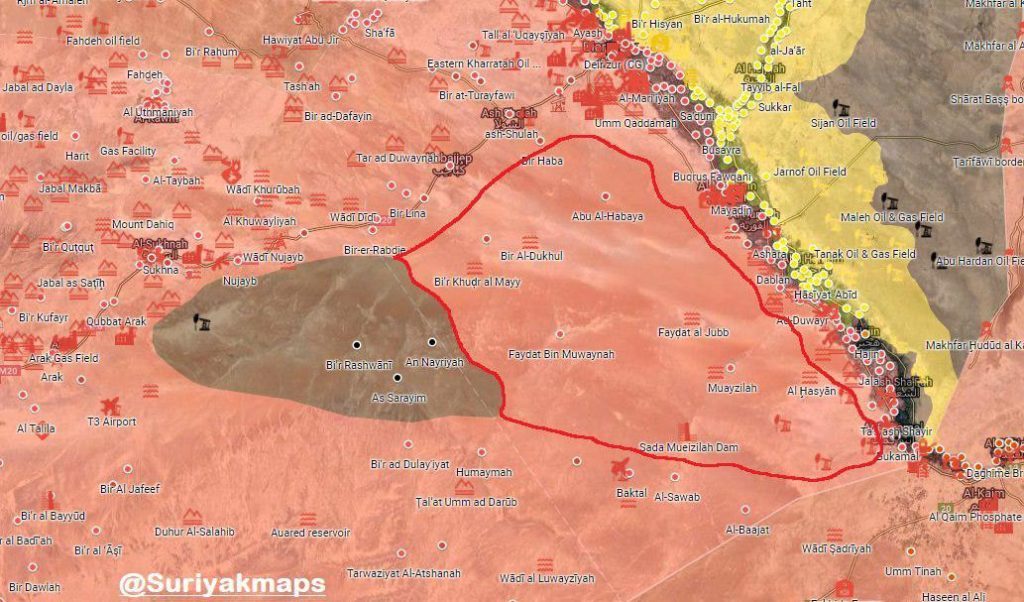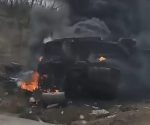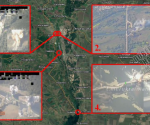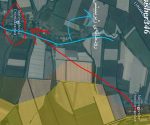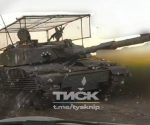“Our boys” are ISIS: the RAF and the SAS at war with the Syrians
More evidence comes of the intrinsic and diabolical nature of the British contribution to the war being waged by several external parties on the Syrian Government, its armed forces, and its people. It appears that in a recent incident, the SAS could well have been with the mercenaries that it trains at al-Tanf, and both were engaged by Syrian forces well beyond the unilaterally imposed exclusion zone by which the US-Coalition would prevent Syrian forces from approaching the southern portion of its illegal presence in the country.
The Jaysh Maghawir al-Thawra, or MaT as they are known, were to have been the contingent of the Free Syrian Army (FSA) that would front US-Coalition fighting all the way to the Euphrates, rather like the Kurdish YPG did out of al-Hasakah. Al-Bukamal, which is a place that has seen lots of activity again recently, was to have been “liberated” from ISIS by MaT to establish “strategic control of the Euphrates River Valley”. It was self evident that the importance of al-Bukamal to the US strangulation of Syria was common knowledge even in 2017 when the Jerusalem Post asked What’s next for US-trained Syrian rebels cut off from fighting ISIS? And it continues to be an objective: the same article reveals that hope persists for MaT: that they will “be partner forces if and when we take on ISIS in the Euphrates River Valley” – thus speaks Col. Ryan Dillon, spokesman for the Combined Joint Task Force-Operation Inherent Resolve (CJTFOIR).
The problem for the American plan, of course, was the 2017 Syrian offensive that retook all the important territory east of al-Tanf all the way down to the Iraqi border, and which caused a pocket of ISIS in the desert south and west of al-Mayadin, and provoked the US into hurriedly switching over territory held by its ISIS puppet into the hands of its SDF puppet in order to keep the Syrian Government forces from occupying large swathes of land east of the Euphrates. If the reader has not come across this idea about how the Americans contrived to control eastern Syria, he or she will certainly not be a long-time reader of FBEL, where the reality of ISIS being a phantom to be disposed of by the US and its “justified” occupation began to be recognised at the start of 2015. More recently this idea was characterised as the US’ “‘rebels’ pour[ing] into territory previously occupied by ISIS – like hot metal into lost-wax mould”.
Moreover, FBEL has never bought the notion of the SDF as a fighting force capable of what it has been credited with (confirmation came with the Turkish invasion of Afrin). In other words, the US “rebel” forces are merely fronts for direct involvement which is always actually aimed at Syrian Government forces. If the truth ever comes out, we will likely find that the British and Americans at al-Tanf have been leading their mercenaries through the desert to change into their ISIS hats, and to take part in the fighting out of the “Mayadin pocket” to recapture Al-Bukamal. The sustained attempts in June 2018 by ISIS upon this town are intrinsically linked with the stated US mission out of al-Tanf; ISIS needs to control it in order to activate the US reaction. Of course, things still did not go the Americans’ way – by the end of June, the Syrians had claimed to have brought under control very large areas of the “Mayadin Pocket” – see the diagram below. Obviously, the effort has been required in order to shut down the rat runs from al-Tanf to the Euphrates. Meanwhile notice that the US leaves alone the ISIS contingent that attacks Al-Bukamal regularly from the eastern bank of the river.
FBEL wouldn’t be the only place on the internet where a vigilant observer of the Syrian war reasonably suspects that US and UK special forces are ISIS (the reader can seek them out for himself). It’s not like the evidence is not there to provoke the suspicion (not counting the many occasions when ISIS leadership have been airlifted out of a scrape by US helicopters). Indeed, at this site recently we looked at a case where a British soldier was officially announced dead in Syria while on a mission with a description that didn’t make any sense, and which was later changed to try and create a slightly more credible story. It was decided hereabouts that the fighting that actually killed this man could very well have taken place in the vicinity of the “Mayadin Pocket” – which is where most of the fighting in Syria had been located during the period the death was supposed to have occurred.
In another FBEL analysis of 2018, it was discovered that British soldiery had very likely been captured in the ranks of the Islamist Jaish al-Islam at Ghouta. And now there is new evidence of British from al-Tanf being present in rat-runs from the Iraqi border up to Palmyra – obviously with no other intention but to engage Syrian forces.
This very week, the Ministry of Defence appeared to admit that at some point in June 2018, a British Typhoon had fired upon Syrian forces. The Times appears to have been the sole and original source of the story in corporate-media (which always speaks volumes):
The RAF bombed pro-Syrian regime forces after a desert battle erupted near a British SAS training base.
A Typhoon fighter jet dropped a 500lb laser-guided bomb during a firefight last month near the intersection of Syria’s border with Iraq and Jordan. A Syrian army officer was killed and seven others were wounded, according to local reports.
The few details released allow us to correlate the incident with others that were reported contemporaneously in June as they happened, and by doing so we can find a very good match; in fact, an attack that took place on the 21st or 22nd of June is probably the same event as the one that The Times admits to on behalf of the Ministry of Defence. The following is from Reuters:
A Syrian army officer was killed in a U.S strike on a Syrian army outpost near a U.S. base close to the Iraqi-Syrian border, a commander in the regional alliance supporting President Bashar al-Assad told Reuters.
The Pentagon, said, however, that a U.S.-backed Syrian rebel group stationed in the Tanf garrison had engaged on Thursday evening an “unidentified hostile force” outside a “deconfliction zone” around the garrison, forcing it to retreat. It said there were no casualties on either side.
Notice that CJTFOIR admits that the engagement took place outside the area that it is has forbidden the Syrians to be in. Here is another report about the very same incident, this time from Sputnik, and just about in its entirety:
At least one Syrian soldier was killed in a US-led coalition airstrike on Syrian army positions in the east of Homs province on Thursday, a Syrian field commander told Sputnik.
The combat planes belonging to the coalition led by the United States, attacked the army position in Jabal Ghurab, some 150 kilometers [93 miles] east of Palmyra near the border with Iraq,” the commander said.
…the sudden US-led coalition air assault occurred [sic] after Syrian forces responded to an open fire from three coalition’s vehicles, moving towards positions of governmental forces…
[it] claimed the life of a Syrian Officer, leaving several other Syrian soldiers injured.
According to a Syrian field commander, coalition vehicles were spotted moving away from At (sic) Tanf district, where the US-led coalition base is situated.
Such an open skirmish between Syrian governmental forces and US-led coalition troops reportedly occurred (sic) for the first time since the outbreak of the war in Syria.
Last week, the Russian reconciliation center reported that the Syrian government troops backed by the Russian Aerospace Forces prevented militants’ audacious breakthrough out of the At Tanf area towards Palmyra.
And so the story develops so that more than one plane was involved, and they were called in as a response to counter attacks staged by the Syrians after initial attacks by Coalition forces.
The other attack out al-Tanf towards Palmyra was told of at Southfront, where the Russian complaint was also expounded upon:
Pro-government forces, supported by the Russian Aerospace Forces, have foiled a militant attack on the government-held ancient city of Palmyra from the US-held area of Al-Tanf in eastern Syria, the Russian military said in a statement on June 11…
The statement added attempts by militants to carry out operations from the Al-Tanf area are carried out on a regular basis.
What is this telling us? That the US and the British are launching missions out of al-Tanf across south-central and south-eastern Syria to attack Government forces. But what of the personnel involved in these raids? There are more clues.
In a remarkable coincidence, another delayed war report came into public view in the last few days, and it could shed some more light:
A UK Royal Air Force (RAF) C-130J-30 has been written off in Iraq after being seriously damaged in a heavy landing during an apparent special forces mission.
The previously undisclosed incident took place last August during the height of coalition operations against the so-called Islamic State (IS) in northern Syria around Raqqa. This is the first UK air loss during Operation ‘Shader’, the codename for its participation in the war against the IS.
Southfront, which may well have been able to access the rest of the Jane’s article (sign-in to view), took up the tale:
According to reports, the… transport aircraft… picked up US and UK troops at a desert airstrip in Syria and returned to Iraq where it suffered a heavy landing at an airbase near the northern city of Erbil.
To deal with the information as a whole: well, don’t pay attention to what a bunch of known liars say about the “when” of the incident – focus on the way that you are supposed to believe that all of a sudden, an RAF pilot suddenly couldn’t land at an airfield. Perhaps it had been badly damaged as it was taking off, say from hostiles on the ground who were trying to stop it taking off, or – more likely – the damage had been caused by an improvised landing to extract a bunch of supposed tough guys, now with their backsides hanging out of their trousers having had them handed to them, from a dangerous situation? And if there was a transport plane on the ground in a situation where it was incredibly vulnerable, then no wonder a Typoon would make an incredibly rare appearance to drop a bomb on proper Syrian troops.
Some people might not see it, but it is quite clear to the author of this article, that a new phase may well have started in the Syrian war. Remember that line from the Sputnik report? “Such an open skirmish between Syrian governmental forces and US-led coalition troops reportedly occurred (sic) for the first time since the outbreak of the war in Syria”. We may yet see some more – and so it’s no wonder that the likes of the Independent are retailing stories about the inexplicable, unfeasible resurrection of ISIS: “claiming a lethal toll, including the lives of Russian soldiers; the capture and executions of rival militia fighters; the seizure of territory with new bases being set up.”
The Syrians have won the war; the Israelis have been beaten (as discussed here) and are begging Syria to behave herself as her patient troops near the Golan Heights. Soon Daraa, somewhat the cradle of all the trouble (and where an ISIS contingent still snuggles up, trouble free, to Israeli demarcation lines), will be in Government hands, and according to many, it really is only a matter of time before the Kurds of the YPG make a deal with Assad. The only way that the US and the UK can cling on is to reprise ISIS – except it isn’t really ISIS.
Wives and mothers, if the Ministry of Defence gets in touch to tell you that your boy was killed while on active service, then there is a good chance, despite what you are told, that he got snuffed out by the Syrians for a war criminal.




